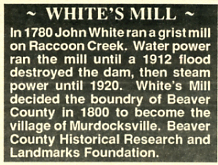
Click Here to Return to Milestones

Late in October 1992 my husband Eliot and I visited the former site of a grist mill along Raccoon Creek in Beaver County. This was White's Mill which operated from 1780 to 1920.
Mr. Allen Cox, who lives in the former miller's house and owns a number of acres on both sides of the creek, was our guide. We tramped through quiet woods to the site of the dam. Large rocks along the shore and in the water indicated the location, and in the clear water 16" wooden beams could be seen. Cox theorizes that "these could have been used for stability. The acid in the water has preserved or pickled them." He told us of making stilts to cross the cold water and ice in the winter. Once while crossing on a bitter day, the ice was breaking free and upset him while carrying two chain saws over his shoulders. His wet clothes froze stiff before he reached home, making walking difficult.
Above the dam and through the woods can be seen traces of the millrace. We walked downstream to the mill site where a depression was evident at the location of the mill wheel. That and some large, hand-chiseled foundation rocks are all that's left of a once busy operation. Cox has located pieces of equipment formerly used in the mill. Also in the area are some large pieces of granulated slag, evidently from a road fill, and quite a bit of shale breaking off a cliff. Some piece were red and some blue, which went clear through, Cox said. He also found some rounded rocks which he thinks may have been used earlier by Indians grinding com and wheat at the same place.
As we looked out across the creek to a cornfield, Cox related that he had seen several flocks of wild turkeys, about 200 in all, feeding there one day. When a dog spooked them, they all rose and flew over his head. He passed on the lore that crows and wolves do not mate when the flocks and herds are abundant.
At Eliot's instigation, The Beaver History and Landmarks Foundation placed a historical marker at the Murdocksville bridge over Raccoon Creek near the mill site on June 23, 1992, which reads as follows:
And we are left to imagine how the mill was a social center in the old days, where people came with corn and wheat to grind and stayed to exchange family news and talk of the new-fangled inventions.